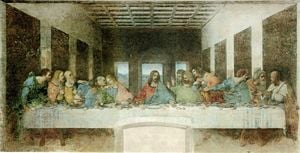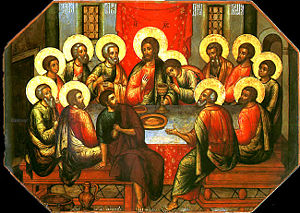The Last Supper

In the christian Gospels, the Last Supper was the last meal Jesus shared with his Twelve Apostles before his death. It has been the subject of many paintings, perhaps the most famous by Leonardo da Vinci. In the course of the Last Supper, and with specific reference to taking the bread and the wine, Jesus told his disciples, "Do this in remembrance of me," (1 Corinthians 11:23–25). Many Christians describe this as the institution of the Eucharist.
New Testament
Earliest Description
The first written description of the Last Supper is that of the Apostle Paul in Chapter 11 of his first letter to the Corinthians:
For I received from the Lord what I also passed on to you: The Lord Jesus, on the night he was betrayed, took bread, and when he had given thanks, he broke it and said, "This is my body, which is for you; do this in remembrance of me." In the same way, after supper he took the cup, saying, "This cup is the new covenant in my blood; do this, whenever you drink it, in remembrance of me." For whenever you eat this bread and drink this cup, you proclaim the Lord's death until he comes. (1 Corinthians 11:23-26)
Paul indicates he learned of the ceremony directly from the Lord, that is by revelation. The Synoptic Gospels present more details, while repeating many of the words given by Paul.
The fact that Paul claims to have learned what happened at the Last Supper through revelation leads modern scholars to speculation that the tradition of the Last Supper may be based on what Paul believed to have happened, rather than on an oral tradition passed on by eye witnesses. In this theory, the Gospel writers relied on the tradition established by Paul, which they later incorporated into their texts.
Gospel accounts
According to the synoptic gospels, Jesus had instructed a pair of unnamed disciples to go to Jerusalem to meet a man carrying a jar of water who would lead them to a house, where they were to ask for the room, specified as being the "upper room." There, they were to prepare the Passover meal.
In the course of the meal—according to Paul and the synoptic gospels, but not John—Jesus divides up some bread, says a prayer, and hands the pieces of bread to his disciples, saying "this is my body." He then takes a cup of wine, offers another prayer, and hands it around, saying "this is my blood of the everlasting covenant, which is poured for many." Finally, according to Paul and Luke, he tells the disciples "do this in memory of me." This event has been regarded by Christians of most denominations as institution of the Eucharist or Holy Communion.
The account in John differs considerably from the above description, where the meal is clearly a Passover Seder. In Luke 22:15 Jesus even says, "I have eagerly desired to eat this Passover with you." In John, however, the meal is not a Passover meal, for the Passover lambs have not yet been slaughtered in the Temple. In John 13, however, a meal takes place "just before the the Passover Feast." Here, Jesus famously washes his disciples feet. Some of the other details make it clear that this is the same event that the synoptic Gospels describe, such as Jesus' prediction of Peter's denial. However, there is no partaking of bread and wine or the institution of the Eucharist, for in John's Gospel, Jesus has indicated from the beginning of his ministry that his disciples must eat his body and eat his flesh to enter the Kingdom of Heaven.
According to the synoptic accounts, during the meal Jesus reveals that one of his Apostles would betray him. Despite the assertions of each apostle that it would not be he, Jesus reiterates his prediction and goes on to place a curse on the man, saying: "Woe to the man who betrays the Son of Man! It would be better for him if he had not been born. "Mark 14:20-21). Neither the Gospel of Mark nor the Gospel of Luke identifies the betrayer yet, but the Gospel of Matthew (26:23-26:25) and The Gospel of John (John 13:26-13:27) specify that it is Judas Iscariot
As well as the prediction of betrayal, all four canonical gospels recount that Jesus knew the apostles would "fall away." Simon Peter insists that he will not abandon Jesus even if the others do, but Jesus declares that Peter will deny Jesus three times before the cock had crowed twice. Peter insists that he will remain true even if it means death, and the other apostles are described as stating the same about themselves.
After the meal, according to John (but not mentioned at all by the synoptics), Jesus gives a large sermon to the disciples, often described as his "farewell discourse."
Remembrances
The institution of the Eucharist at the Last Supper is remembered by Roman Catholics as one of the Luminous Mysteries of the Rosary, and by most Christians as the "inauguration of the New Covenant," mentioned by the prophet Jeremiah, fulfilled by Jesus at the Last Supper, when He said, "Take, eat; this [bread] is My Body; which is broken for you. Par-take of the cup, drink; this [wine] is My Blood, which is shed for many; for the remission of sins." Other Christian groups consider the Bread and Wine remembrance as a change to the Passover ceremony, as Jesus Christ has become "our Passover, sacrificed for us" (I Corinthians 5:7). Partaking of the Passover Communion (or fellowship) is now the sign of the New Covenant, when properly understood by the practicing believer.
Each major division of Christianity has formed a different theology about the exact meaning and purpose of these remembrance ceremonies, but most of them contain similarities.
Development in the early church
Early Christianity has created a remembrance service that took place in the form of meals known as agape feasts: perhaps Jude, and the apostle Paul have referred to these as your love-feasts, by way of warning (about who shows up to these). Agape is one of the five main Greek words for love, and refers to the idealized love, rather than lust, friendship, hospitality, or affection (as in parental affection). Though Christians interpret Agape as meaning a divine form of love beyond human forms, in modern Greek the term is used in the sense of I love you - i.e. romantic love.
These love feasts were apparently a full meal, with each participant bringing their own food, and with the meal eaten in a common room. Early Christianity observed a ritual meal known as the "agape feast" held on Sundays which became known as the Day of the Lord, to recall the resurrection, the appearance of Christ to the disciples on the road to Emmaus, the appearance to Thomas and the Pentecost which all took place on Sundays after the Passion. Jude, and the apostle Paul referred to these as "your love-feasts," by way of warning (about "who shows up" to these). Following the meal, as at the Last Supper, the apostle, bishop or priest prayed the words of institution over bread and wine which was shared by all the faithful present. In the later half of the first century, especially after the martyrdom of Peter and Paul, passages from the writings of the apostles were read and preached upon before the blessing of the bread and wine took place.
These meals evolved into more formal worship services and became codified as the Mass in Catholic Church, and as the Divine Liturgy in the Orthodox Churches. At these liturgies, Catholics and Eastern Orthodox celebrate the Sacrament of the Eucharist. The name Eucharist is from the Greek word eucharistia which means thanksgiving.
Name
Within many Christian traditions, the name Holy Communion is used. This name emphasizes the nature of the service, as a "joining in common" between God and humans, which is made possible, or facilitated due to the sacrifice of Jesus. Catholics typically restrict the term 'communion' to the reception of the Body and Blood of Christ by the communicants during the celebration of the Mass.
Another variation of the name of the service is "The Lord's Supper." This name usually is used by the churches of minimalist traditions; such as those strongly influenced by Zwingli. Some echoes of the "agape meal" may remain in fellowship, or potluck dinners held at some churches.
As well, The Church of Jesus Christ of Latter-day Saints commonly refers to the service as The Sacrament.
See also
- New Covenant (theology)
- Round dance of the cross
- [[wikisource:Catholic Encyclopedia (1913)/The Last Supper "|The Last Supper]".] Catholic Encyclopedia. (1913). New York: Robert Appleton Company.
ReferencesISBN links support NWE through referral fees
Brown, Raymond Edward. An Introduction to the New Testament. The Anchor Bible reference library. New York: Doubleday, 1997.ISBN 9780385247672
Brown, Raymond Edward, Joseph A. Fitzmyer, and Roland Edmund Murphy. The New Jerome Biblical Commentary. Englewood Cliffs, N.J.: Prentice-Hall, 1990.ISBN 9780138598365
Kilgallen, John J. A Brief Commentary on the Gospel of Mark. New York: Paulist Press, 1989.ISBN 9780809130597
External links
All liks retrieved November 27, 2007
- Site of "Last Supper," tourism.gov.il
- A Different Da Vinci Code The missing pieces of Leonardo's puzzle point to plain and simple Hermeticism (altreligion.about.com article).
- Was the "Last Supper" the Passover Meal?
- A zoomable 16 billion pixel image of the Last Supper
- The Last Supper interpreted by 7 Artists
- Leonardo da Vinci - The Last Supper (Zoomable Version)
- The Last Supper (Virtual Tour and super high resolution image)
- Passover observance for New Covenant Christians
- The Soteriologic Significance of the Last Supper
- Jewish Encyclopedia: Jesus: The Last Supper
- Frescos of Last Suppers in the Renaissance Refectories of Florence
Credits
New World Encyclopedia writers and editors rewrote and completed the Wikipedia article in accordance with New World Encyclopedia standards. This article abides by terms of the Creative Commons CC-by-sa 3.0 License (CC-by-sa), which may be used and disseminated with proper attribution. Credit is due under the terms of this license that can reference both the New World Encyclopedia contributors and the selfless volunteer contributors of the Wikimedia Foundation. To cite this article click here for a list of acceptable citing formats.The history of earlier contributions by wikipedians is accessible to researchers here:
The history of this article since it was imported to New World Encyclopedia:
Note: Some restrictions may apply to use of individual images which are separately licensed.


